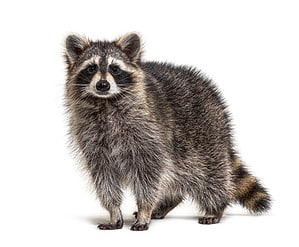If you live in North America, you’ve likely encountered a raccoon. They range from Canada through Central America in the millions. What’s more, they’ve now become an invasive species in Central Europe and Japan. Highly intelligent, resilient, and able to manipulate objects with dexterous fingers, raccoons can adapt to all sorts of environments. They are no longer only a rural species but have become a full-fledged urban species as much as pigeons, rats, and feral cats. No matter where in the nation you live, you might encounter raccoons while on a hike, having a picnic, taking out your garbage, or even at home, as they can climb into your walls and attic. In this article, we’ll help you identify some of the most common raccoon sounds and what they mean, so at least you’ll have a better idea of what you’re dealing with.
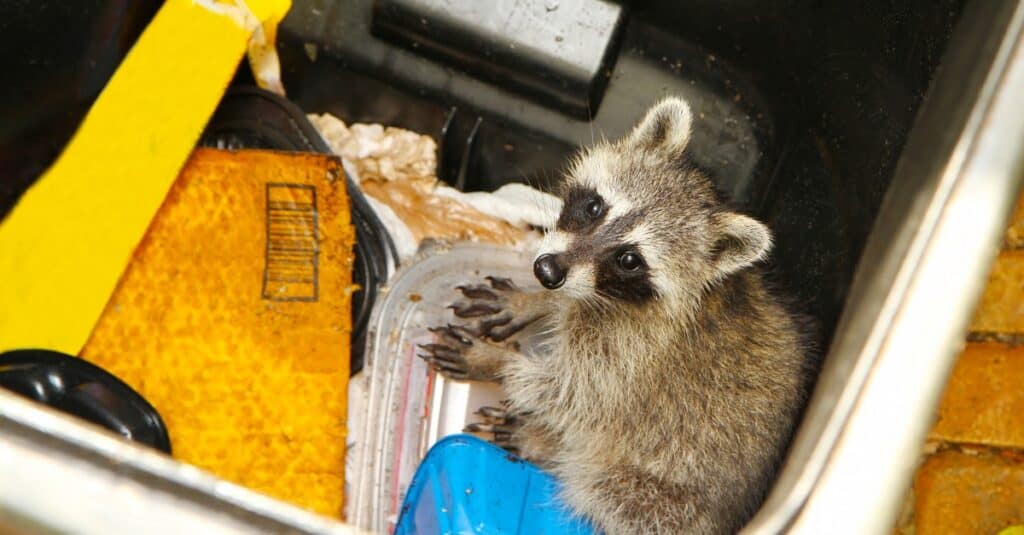
Imagine seeing this when you take a bag of trash out to your garbage can . . . what would you do?
©Jillian Cain Photography/Shutterstock.com
What’s the Deal with Raccoons?
From time to time, you may wonder why there are so many raccoons, and why are they always rummaging around and making all kinds of noise. As with any animal, a raccoon’s main concerns are to find food, mate, and protect themselves and their young. The sounds they make are ways to communicate with one another or warn away predators. As omnivores and scavengers, they eat fruit, nuts, insects, fish, snails, small reptiles, and carrion. Raccoons are pretty darn cute, especially when you drive into your neighborhood at night and spot a mama with four babies trailing her in a line across the road. But they are also noisy, messy, and disease-bearing critters.
Why are There So Many Raccoons?
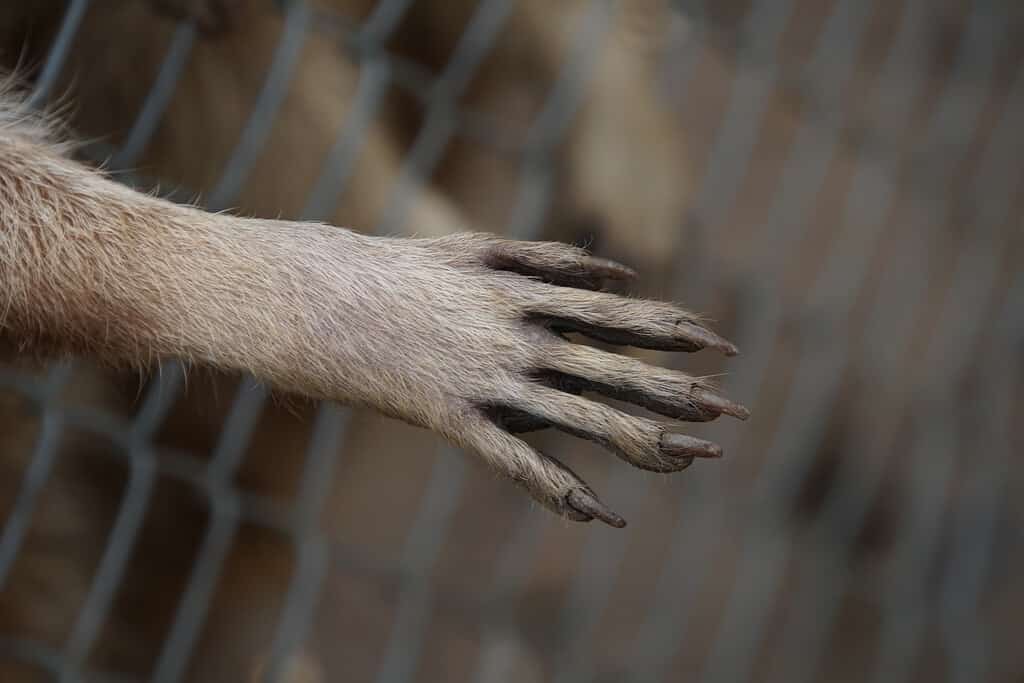
Raccoons have dexterous fingers that enable them to make fine movements that other animals can’t.
©Julija Ogrodowski/Shutterstock.com
Raccoons have multiplied explosively in North America primarily because of the enormous amount of food waste our affluent society creates. Overflowing trash bins provide an easy meal for them. They have an advantage in rummaging due to their sensitive, five-fingered hands with a highly developed sense of touch. They can find ways to open latches and packages and pick up small bits of food. Raccoons hear and see well, especially at night. They can also run and climb well and can even swim if they have to! They do have their predators, though. Coyotes, bobcats, birds of prey, and even invasive pythons in the Everglades help keep their population down.
Are Raccoons Dangerous?
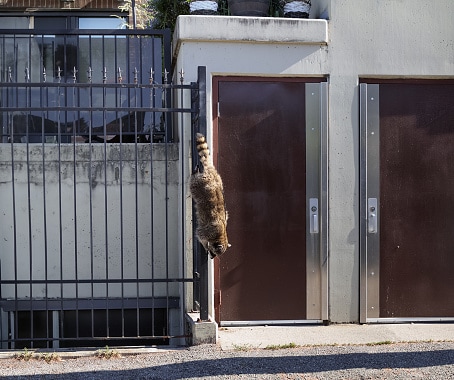
Raccoons are supremely agile.
©Petra Richli/iStock via Getty Images
No doubt about it, these rascally little bandits with their black “masks” are adorable. And they serve the environment by eating carrion and spreading seeds that cling to their fur or get expelled in their waste. However, these dirty little “trash pandas” scatter garbage around the neighborhood, fight with pets, and spread contagious diseases like rabies, roundworm, or distemper. They can also get into the crawlspaces, attics, and walls of homes, damaging insulation, fraying wiring and creating a fire hazard, and leaving behind smelly waste. And since they’re active at night, the eerie sounds they make can have you thinking it’s time to call an exorcist!
What Sounds Do Raccoons Make?
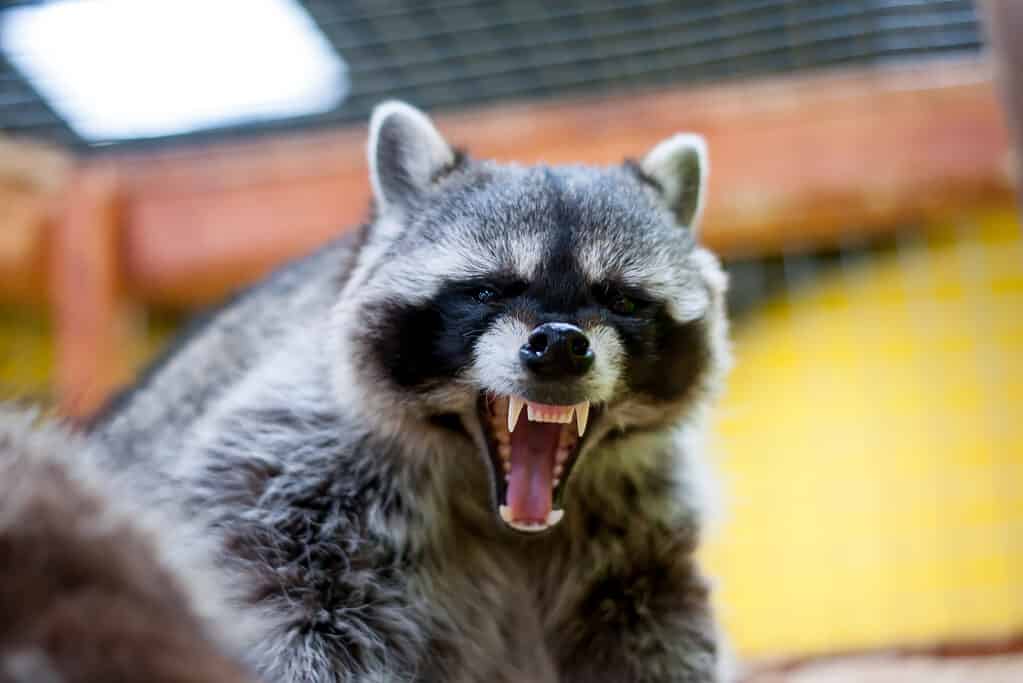
Raccoons make over 200 sounds, including some that are pretty scary.
©Vital9s/Shutterstock.com
Raccoons are a very vocal species, making over 200 different sounds. Of course, we won’t describe all of those here, but below are some of their most common noises, and what they typically mean.
1. Growling
When a raccoon is in danger or angry and trying to defend itself, it growls like a dog. Its growl can start off as deep base rumbling, turn into a snarl, and continue rising into piercingly loud noises that can sound like yelling. This can be accompanied by body language: the raccoon will lower its head, arch its back, lift its fur, and poof up its tail to make it look bigger.
2. Chittering
This sounds like purring and clicking at the same time. Mothers communicate with their babies this way to calm them, and the babies do it to call their mothers. As adults, raccoons make the same mother/baby noises to soothe themselves when they are anxious or afraid.
3. Hissing
Usually, raccoons are a pretty non-aggressive species. But when they feel threatened, in danger, or angry, they can make a hissing sound. They may also make this noise when rabid. Males often make these noises while competing with one another during mating season, from January through March. Hissing often signals the beginning of a fight, which quickly escalates to violence and a variety of other aggressive, vicious noises. Mothers will also hiss at males that get too close to their babies.
4. Purring, Cooing

A happy fluffy little raccoon will purr and coo as if to say “Ah, life is good!”
©sinagrafie/Shutterstock.com
Raccoons can make a faint purring sound like kittens. These sounds are often heard in young ones, but adults make them too when they’re extremely happy and content. If you hear this sound, you did something right for your resident raccoon! (And if you don’t want it to stay, maybe stop doing that!)
5. Screaming, Screeching
When a raccoon is in intense distress or pain, it can make squealing, screeching, owl-like noises. These can be loud enough for you to hear inside the house with the windows closed. This may signal an injured animal. But it could also be an indication of a rabid animal. Rabies is a fatal disease that can spread to people and animals through bites or scratches. Raccoons are one of the main carriers of rabies in the United States, so if you hear such noises or see abnormal behavior in a raccoon, steer clear and call wildlife officials. And what constitutes abnormal raccoon behavior? Check out this terrifying video:
6. Mewing, Whining
These are the crying sounds a baby raccoon makes when it’s scared, hungry, lonely, or just having a generally bad time and wants its mommy. These sounds could come from a baby raccoon that has lost its mother to traffic or a predator, or it could be the mother is nearby and will return to defend her baby if you get too close to it. It’s best to leave it where you found it and let nature take its course.
If you feel you must intervene, you can put on heavy gloves to avoid being bitten or throw a thick blanket over the baby. Put it in a cardboard box it cannot climb out of and leave it where you found it. If the mother is near, she will come and set it free. Otherwise, if you return in a day and it is still there, collect the baby in the box and call local wildlife authorities to take care of it.
7. Barking
A raccoon can bark like a dog. Its bark is often combined with a growling sound. It means they are excited or stressed, in either good or bad ways. Mothers use it to call their babies when they’re out of sight. Some raccoons might use it when they’re eating some particularly yummy garbage. They can also use it as part of a threat display to scare off a predator.
What Do Raccoons in Your House Sound Like?

If your dog is staring at the wall . . . there could be a raccoon in it.
©Anastasiia Cherniavskaia/Shutterstock.com
If you have a raccoon in your walls, ceiling, or attic, you may notice rustling and scratching noises as it digs around in the insulation to build a nest. Gnawing noises might be audible as it chews through siding and wood to enlarge an entry hole or access other parts of the house. You’ll hear faint pitter-patter footsteps as it rummages around looking for food or nesting materials. There might be a little screeching as the mother and babies communicate with each other.
Even if you can’t hear these noises, your dog with his vastly better hearing can. Has your dog ever started barking at one spot on the wall or the ceiling? Don’t worry; it’s not a poltergeist. By far, the most likely explanation is a raccoon or some other critter rummaging around the innards of your house. It doesn’t hurt to have a priest bless your house . . . but call a wildlife removal expert too.
The photo featured at the top of this post is © iStock.com/GlobalP
Thank you for reading! Have some feedback for us? Contact the AZ Animals editorial team.




